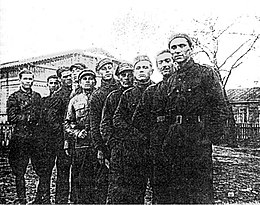This is an old revision of this page, as edited by Cyberbot II (talk | contribs) at 17:48, 24 June 2016 (Rescuing 1 sources. #IABot). The present address (URL) is a permanent link to this revision, which may differ significantly from the current revision.
Revision as of 17:48, 24 June 2016 by Cyberbot II (talk | contribs) (Rescuing 1 sources. #IABot)(diff) ← Previous revision | Latest revision (diff) | Newer revision → (diff)| Naliboki massacre | |
|---|---|
 Naliboki self-defence leaders possibly in a meeting with the Soviet officer (far left) prior to being massacred Naliboki self-defence leaders possibly in a meeting with the Soviet officer (far left) prior to being massacred | |
| Location | Naliboki German-occupied Poland |
| Date | May 8, 1943 |
| Weapons | Shootings by automatic and semi-automatic weapons |
| Deaths | 120-129 Polish nationals |
| Perpetrators | Soviet partisans |
The Naliboki massacre (Template:Lang-pl) was the mass killing of aproximately 128 Poles including boys by Soviet partisans on May 8, 1943 in the village of Naliboki in German-occupied Poland (now Belarus). Before the Nazi-Soviet invasion of Poland of 1939, Naliboki belonged to Stołpce county of the Nowogródek Voivodeship in eastern Second Polish Republic.
Background
Following the Nazi German Operation Barbarossa against the Red Army, the Soviets deployed their own resistance in Puszcza Nalibocka behind the German front lines of eastern Poland. The leaders were sent by the NKVD in 1942 with access to military hardware. The members came from among the former Red Army soldiers, and pro-Soviet Belarusians. All provisions were acquired by force from settlements whose inhabitants were treated as enemies. The killings of peasants in order to inflict terror during acquisitions began in 1943 (in Kamień, Derewno, Borowikowszczyzna, Dziagwie, Rodziewszczyzna, etc). Naliboki was one of the settlements usually raided by them. Resulting from this, in August 1942 a self-defence unit was formed in the village.
In March 1943 the Soviet partisans arranged for a meeting with the Polish self-defence leaders, and lied about their intentions. An agreement was signed with the Poles represented by Eugeniusz Klimowicz against the common robbers hiding in the forest. The NKVD did not intend to respect the agreement amounting to little more than a smokescreen, and a surveillance technique.
The massacre
On the night of May 8–9, 1943, the Soviet partisans raided Naliboki from the depths of the Naliboki Forest. A few of the Soviet attackers, including one political officer, were killed by the defenders. Polish men were pulled from their homes, and than shot individually or in small groups. Many farmhouses were set on fire. The mass looting followed. Also killed during the Soviet attack were three Polish women, several teenagers and a ten-year-old boy. The town's church was set on fire along with the public school, fire station, and the post office. The raid took two to three hours. The Soviet commandant delivered a report to NKVD about the killing of 250 people, the capture of weapons, round up of 100 cows and 78 horses, and the destruction of a German garrison. In reality the number of victims was lower (now estimated at 120-129); no Germans were present in the village, and none killed, only one Belarusian auxiliary policeman happened to be sleeping in the town during the night of the attack.
Naliboki was completely burned down by the Germans four months later, in August 1943, as part of a massive anti-partisan action code-named Operation Hermann. The remaining inhabitants were taken to Germany for forced labor.
Bielski partisans
The Soviet partisans in the region were often joined by the Jews escaping from the Nazi ghettos. The controversy, as noted in a communique released by the IPN, concerns the participation of the Bielski partisans who might have supported the Soviets in the attack based on their co-operative relationship. Survivors of the Bielski group have denied this, particularly after the release of a film about them, entitled Defiance. The Polish Institute of National Remembrance has been investigating the massacre. Although the IPN has not reported its findings as of April 2009, one researcher from the institute has said that there's no evidence to support the allegation that the Bielski partisans were involved in the attack. A few years earlier, prosecutor Anna Gałkiewicz from KŚZpNP in charge of the investigation informed that surviving witnesses recognized their Jewish neighbours from the partisan group of Tuvia Bielski participating in the attack.
See also
References
- ^ Anna Gałkiewicz, prokurator Oddziałowej KŚZpNP w Łodzi (14 May 2003). "Omówienie dotychczasowych ustaleń w śledztwach w sprawach o zbrodnie w Nalibokach i Koniuchach". Spotkanie Klubu Historycznego im. gen. Stefana Roweckiego - "Grota" w Instytucie Pamięci Narodowej. Warszawa: Komisja Ścigania Zbrodni przeciwko Narodowi Polskiemu, KŚZpNP. Archived from the original on April 29, 2009.
{{cite web}}: Unknown parameter|deadurl=ignored (|url-status=suggested) (help) - ^ IPN (November 2013). "Śledztwo w sprawie zbrodni popełnionych przez partyzantów radzieckich na żołnierzach Armii Krajowej i ludności cywilnej na terenie powiatów Stołpce i Wołożyn woj. nowogródzkie (S 17/01/Zk)". Śledztwa w biegu - Zbrodnie komunistyczne. Instytut Pamieci Narodowej. Retrieved 25 January 2014.
- ^ IPN (1 March 2002), Investigation Reports on Koniuchy and Naliboki, Institute of National Memory, retrieved 19 January 2014
- IPN. "Komunikat dot. śledztwa w sprawie zbrodni popełnionych przez partyzantów sowieckich w latach 1942–1944 na terenie byłego województwa nowogródzkiego" (in Polish). Instytut Pamięci Narodowej. Retrieved 13 January 2013.
- A Hollywood Movie About Heroes or Murderers?, Gazeta Wyborcza, 2008-06-16.
- The True Story of the Bielski Brothers Template:Pl icon Prawdziwa historia Bielskich, Gazeta Wyborcza, 2009-01-06
- Kamil Tchorek (2008-12-31). "Country split over whether Daniel Craig is film hero or villain". The Times. Retrieved 2008-12-31.
{{cite news}}: Italic or bold markup not allowed in:|publisher=(help) - Template:Pl icon Bielski w puszczy niedomówień, Rzeczpospolita, 31-01-2009
External links
Categories: